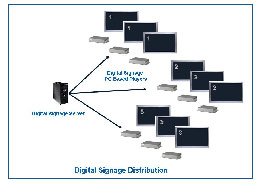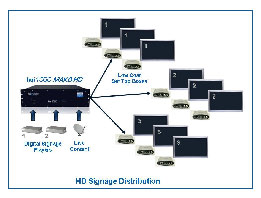|
Digital signage is the use of digital systems
and electronic displays to provide promotional and other types of messages
to viewers or potential customers. Companies and broadcasters use digital
signage systems to effectively, rapidly, and efficiently provide messages
to bothpublic and private areas (such as companies, hotels, and sports
stadiums).
Traditionally, digital signage vendors have
relied on a server client model for content distribution. The server runs
the content management and scheduling software and pushes templates and
content to "signage players" that are placed in close proximity to the
display devices. With the advent of cost effective HD encoding and very
low cost compact set top boxes (STBs), the signage environment in many
cases can migrate to simple AV over IP (digital television) architectures
- HD Signage. Content for the HD signage architecture is encoded as HD
video in a content head end with all channels distributed live throughout
the network to each endpoint display. |
Digital Signage Model
Digital signage systems based on the sever
client model encompass an "all PC" architecture. The central servers
store and distribute content and templates that run on the digital
signage players placed at each display endpoint. The servers comprise
two components - 1) a powerful server PC and 2) the signage management
system. The digital signage players comprise 2 components - 1) the
hardware platform which is almost always a very compact PC platform
and 2) the player software on that platform. Digital signage systems
may include software that simplifies content creation.
HD Signage Model
Media integrators can take advantage of HD
encoding to establish internal broadcast channels for signage. The
high definition channels are distributed to very low cost set top box
appliances, live, and in real time. This approach provides an
independent infrastructure that does not rely on the content system.
Any content, live or generated by a content server, can be injected
into the agnostic HD distribution |
|
|
|
 |
|
Figure 1.Digital Signage Distribution |
|
 |
|
Figure 2, HD Signage Distribution |
|
environment for distribution to any endpoint.
The infrastructure is 100% industry standard, with encoders and endpoints
simply exchanging H.264 live network video. Grouping and distribution is
easily accommodated through multicast network technology to an unlimited
number of endpoints free from software licensing requirements.
Endpoint Cost
Traditional digital signage endpoints require a
digital signage placer (a PC appliance) which ranges in cost from $500 to
$2000. Digital signage vendors may also charge a software license for each
digital signage player platform that can range from$300 to $500 or more in
addition to the player. The average price for an endpoint player/software
system is estimated to be approximately $2000 per endpoint. |
The cost of a high definition set top box
(comparable to a compact version of a home digital cable receiver and
pervasive in the hospitality industry for in-room video on demand) can
be less than $400 providing a savings of more than $1600 per display
endpoint!
Endpoint Longevity
Digital signage players have traditionally
been based on personal computers. Owners of these devices are at the
mercy of needs for operating system upgrades and signage system
upgrades that may require additional graphics power. The useful life
of PCs can be relatively short when compared to longevity of
television set top boxes. Once a STB is deployed that has high
definition capability (H.264), it can perform that task for its entire
life without the need for upgrades or additional software updates.
|
|
 |
|
Figure 3, HD Digital Costs |
|
 |
|
Figure 4, HD Signage Management |
|
Bandwidth Efficiency
The new industry television media standards
such as the MPEG-4 H.264 video compression system has replaced less
efficient MPEG-2 video compression technology. While the MPEG-4 systems
was designed to provide HD signals using 4 to 8 Mbps, it was also
efficiently designed to provide other formats of media such as static
images and text. The data transfer requirements for text based media are
hundreds or thousands of times lower than the data transmission rate for
video transmission.
If multicast (one-to-many packet processing) is
not available on the target network, or if a multicast CAT5 data network
cannot be installed, the number of display endpoints served with real time
HD will be limited to the number of streams each encoder can produce or
the STBs can include DVR storage systems to operate in a process that is
similar to existing digital signage systems (download, store, and play).
Content and the Sales Process
Digital signage systems rely on designers and
operators to create scripts (command and control sequences) that are
applied to each zone using the signage network managers and broadcast
servers. |
This can be a complex value chain that
requires the use of complex tasks and skill sets. As a result, the
sales process for the integrator is content centric, and involves the
extensive training of personnel from many different departments.
By adopting the simpler model of
distributed AV over IP, this can simplify both the content creation
and sales processes. HD Signage integrators can install video
broadcast systems to drive the displays and very easily establish
channels and groups. Live content from broadcast sources, content
internally generated or content from signage servers can easily be fed
into the internal channels and endpoint groups. The integrator
delivers an end to end distribution system that DOES NOT rely on a
customized content system. The sales process is easier; the client has
lower costs, increased flexibility, and does not have a system that
relies on a single digital signage vendor.
Benefits of the HD Digital Signage Model
Some of the key benefits of using
television distribution for the digital signage system include the
ability to include live content into the signage displays and
simplified signage management processes. |
|
|
|
Live Content
Television based digital signage systems are
designed to deliver live video content while traditional digital signage
systems are not proficient at delivering live content. Integrating any
content system to a television signage deployment system is rather simple
by configuring the output to be HD resolution and feeding that signal to
the HD encoder.
HD Signage Management
Signage management systems identify, organize,
and distribute messages to groups of end display endpoints. Traditional
signage management systems may offer a limited set of abilities to local
channel selection and display endpoint grouping. Certain groups of
displays carry the same content channel all of the time. Many set top box
manufacturers sell or make available central control software that allows
managers to group and manage their STBs. A number of other companies make
server based control systems to manage and schedule live network video
channels and the STBs that receive them. Such companies offer the ability
to schedule, propagate, and apply simple HTML templates over the video and
operate serial ports for display control. A unique feature of STBs is that
they may be either centrally or locally |
controlled via a
user remote (when enabled, users can simply change channels as easy as
if they were in their living room).
Bringing AV Back
to the Enterprise
Digital signage
has delivered great technology but has over-complicated some simple
facility challenges. HD Signage allows integrators to simply
distribute high quality content throughout a facility or campus,
without a concern for creating the content, managing complex PC
deployments, or incurring substantial endpoint costs for technology
that may ultimately have quite a short lifecycle. |
|
HaiVision Systems
Inc. is a private company and a world leader in delivering the most
advanced video networking technology. HaiVision s products are
deployed worldwide within the foremost telepresence suites and
boardrooms, in healthcare facilities for video collaboration and
training, for continuous presence distance education and remote
learning, and within broadcast for remote interviews, IPTV, and
content distribution. |